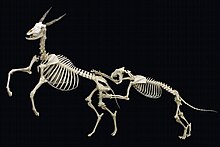Lion
Scientific Classification
| Kingdom: | Animalia |
| Phylum: | Chordata |
| Class: | Mammalia |
| Order: | Carnivora |
| Suborder: | Feliformia |
| Family: | Felidae |
| Genus: | Panthera |
| Species: | P. leo[1] |
What Should You Know about Lion?
Lions are muscular, deep-chested felids with short, rounded heads, reduced necks and round ears. Of the living, non-hybrid felids, the lion is second only to the tiger in length and weight. Its skull is very similar to that of the tiger, although the frontal region is usually more depressed and flattened, with a slightly shorter postorbital region and broader nasal openings than that of a tiger. However, due to the amount of skull variation in the two species, usually only the structure of the lower jaw can be used as a reliable indicator of species. Lion colouration varies from light buff to silverly gray, to yellowish red and dark brown. The underparts are generally lighter and cubs are born with dark spots on their body. The spots fade as lions reach adulthood, although faint spots often may still be seen on the legs and underparts.
Lions are the only members of the cat family to display obvious sexual dimorphism. Males are more robust than females, have broader heads and a prominent mane, which grows downward and backward and covers most of the head, neck, shoulders, and chest. The mane is typically brownish and tinged with yellow, rust, and black hairs. The most distinctive characteristic shared by both females and males is that the tail ends in a dark, hairy tuft. In some lions, the tuft conceals a hard "spine" or "spur", approximately 5 mm long, formed of the final sections of tail bone fused together.
The typical weight range of lions is indicated as 150 to 250 kg (331 to 551 lb) for males and 120 to 182 kg (265 to 401 lb) for females. The size of adult lions varies across their range, with those from the Southern African populations in Zimbabwe, the Kalahari and Kruger Park averaging from 187.5 to 193.3 kg (413 to 426 lb) for males and from 124.2 to 139.8 kg (274 to 308 lb) for females, compared to 174.9 kg (386 lb) and 119.5 kg (263 lb) for male and female lions respectively in East Africa. Measurements of head-body lengths in males range from 170 to 298 cm (5 ft 7 in to 9 ft 9 in), tail lengths of 90–105 cm (2 ft 11 in–3 ft 5 in). Head-body lengths of females range from 140 to 175 cm (4 ft 7 in to 5 ft 9 in), tail lengths of 70–100 cm (2 ft 4 in–3 ft 3 in). The frequently cited maximum head and body length of 250 cm (8 ft 2 in) fits rather to extinct Pleistocene forms, like the American lion, with even large modern lions measuring several centimetres less in length.
Record measurements from hunting records are supposedly a total length of nearly 3.6 m (12 ft) for a male lion shot near Mucusso National Park in southern Angola in October 1973. A male shot in 1936 outside Hectorspruit in eastern Transvaal Province, South Africa, weighed 313 kg (690 lb). Another notably large male lion was shot near Mount Kenya and weighed 272 kg (600 lb). There are also reports of large Asiatic lion.
Unique Facts about Lion
Unique Facts about Lion
- African lions are the most social of all big cats and live together in groups or “prides.” A pride consists of about 15 lions.
- Male lions defend the pride’s territory while females do most of the hunting. Despite this, the males eat first.
- These majestic cats are threatened by habitat loss. The lion is listed as vulnerable on the IUCN Red List of Threatened Species.
- The lion was once found throughout Africa, Asia and Europe but now exists only in Africa with one exception. The last remaining Asiatic lions are found in Sasan-Gir National Park in India, which was primarily created to protect the species. Currently, there are approximately 350-400 lions in the park.
- A lion’s roar can be heard from as far as 5 miles away.
- A lion can run for short distances at 50 mph and leap as far as 36 feet.
- Even though the lion is sometimes referred to as the “king of the jungle,” it actually only lives in grasslands and plains. The expression may have come from an incorrect association between Africa and jungles or may refer to a less literal meaning of the word jungle.
- A good gauge of a male lion’s age is the darkness of his mane. The darker the mane, the older the lion.
- A lion’s heels don’t touch the ground when it walks.
- A lion may sleep up to 20 hours a day.
Source : Wikipedia


Komentar
Posting Komentar